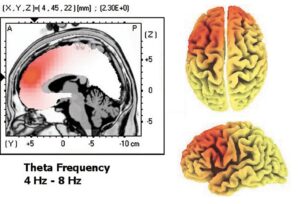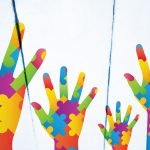Quantitative EEG and Neurofeedback in the Treatment of Attention Deficit Hyperactivity Disorder
Nathan Vitaro, NMD
Attention Deficit Hyperactivity Disorder (ADHD) is the most prevalent behavioral disorder amongst the pediatric population, affecting 3% to 5% of all children and approximately two million American children. The diagnosis of ADHD varies from a short consult with a pediatrician to a more extensive psychological workup including rating scales, IQ and achievement testing and motor skills assessment. Less commonly, neuroimaging techniques are implemented, such as single-photon emission computerized tomography (SPECT) scans or quantitative electroencephalography (qEEG) to develop a greater understanding of brain performance. Children with ADHD typically also qualify for other mental health diagnoses or co-morbidities such as Oppositional Defiant Disorder, Depression, Generalized Anxiety Disorder, Obsessive Compulsive Disorder, Learning Disabilities, sensory integration problems and auditory processing issues. Despite the varying complexity of the diagnostic process, children (and adults) with ADHD are treated very much the same by allopathic practitioners, with a trial of stimulant medications such as methamphetamine (Ritalin, Concerta) or mixed salts of amphetamines (Adderall). Atomoxetine (Strattera), a selective norepinephrine reuptake inhibitor, is also becoming a very popular choice prescription due to its non-stimulant classification. More complex cases are conventionally treated with a combination of prescriptions including stimulants, anti-depressants, mood stabilizers, anti-convulsant drugs and rarely hypotensives, such as clonidine and guanfacine. Because of greater public awareness of ADHD and the side effect panels of conventional prescriptions, parents are now more readily seeking out alternatives for their children and for themselves. Naturopathic physicians with a pediatric patient base have most likely encountered and/or treated children with ADHD. Outside of standard naturopathic treatment with dietary modification, supplementation, homeopathy and chelation which all can be very effective, there is a modality that serves as a valuable adjunct to alternative or conventional treatment. Neurofeedback, sometimes referred to as EEG Biofeedback, serves as a technologically advanced form of biofeedback working specifically with an individual’s EEG to essentially “train the brain” to function optimally. On the leading edge of mind-body medicine, it provides a mode of treatment yielding similar results as with stimulant medications without the negative side effects.
 Before initiating treatment with neurofeedback, many practitioners utilize qEEG to assess a patient’s brain function, as well as to customize the treatment protocol. The process entails an eyes open and eyes closed recording of a patient’s EEG from 19 electrode channels located on the scalp using a conventional system of electrode placement (the 10-20 system). Once completed, the record can be processed using a wide variety of computer programs, such as low resolution brain electromagnetic tomography (LORETA), that are designed to statistically quantify the various brainwaves, localize the source, and often compare the results to a normative database. The information is then compiled to produce topographic brain images which identify the parts of the brain that are producing an excess or deficiency of a given brainwave. From this, we are able to make clinical correlations to brain processes and determine which areas of the brain are being affected by the disorder. Essentially, there are five different types of brainwaves, classified by speed or cycles per second (Hz). Delta waves (0-4 Hz) are predominant during sleep. Theta waves (4-8 Hz) are produced in states of daydreaming or drowsiness. Alpha waves (8-12 Hz) are present when the brain is idle or in states of focused relaxation, while beta waves (12-32 Hz) are required for executive functioning and sustained attention. There is also research on faster waveforms known as gamma (32+ Hz), but most practitioners do not analyze frequencies at such speeds. Research has discovered various EEG patterns of children with ADHD that vary from children without the disorder. Often an excess of theta waves in the frontal lobe is present in children with ADHD. Because the frontal lobe controls the majority of our ability to maintain focus, it makes clinical sense that an overabundance of slower drowsy brainwaves can interfere with tasks requiring sustained focus. The patient might then present with symptoms of distractibility, poor attention span and impulsivity. Current research in the field is defining more patterns associated with other disorders such as depression, anxiety, obsessive-compulsive disorder and chronic fatigue syndrome.
Before initiating treatment with neurofeedback, many practitioners utilize qEEG to assess a patient’s brain function, as well as to customize the treatment protocol. The process entails an eyes open and eyes closed recording of a patient’s EEG from 19 electrode channels located on the scalp using a conventional system of electrode placement (the 10-20 system). Once completed, the record can be processed using a wide variety of computer programs, such as low resolution brain electromagnetic tomography (LORETA), that are designed to statistically quantify the various brainwaves, localize the source, and often compare the results to a normative database. The information is then compiled to produce topographic brain images which identify the parts of the brain that are producing an excess or deficiency of a given brainwave. From this, we are able to make clinical correlations to brain processes and determine which areas of the brain are being affected by the disorder. Essentially, there are five different types of brainwaves, classified by speed or cycles per second (Hz). Delta waves (0-4 Hz) are predominant during sleep. Theta waves (4-8 Hz) are produced in states of daydreaming or drowsiness. Alpha waves (8-12 Hz) are present when the brain is idle or in states of focused relaxation, while beta waves (12-32 Hz) are required for executive functioning and sustained attention. There is also research on faster waveforms known as gamma (32+ Hz), but most practitioners do not analyze frequencies at such speeds. Research has discovered various EEG patterns of children with ADHD that vary from children without the disorder. Often an excess of theta waves in the frontal lobe is present in children with ADHD. Because the frontal lobe controls the majority of our ability to maintain focus, it makes clinical sense that an overabundance of slower drowsy brainwaves can interfere with tasks requiring sustained focus. The patient might then present with symptoms of distractibility, poor attention span and impulsivity. Current research in the field is defining more patterns associated with other disorders such as depression, anxiety, obsessive-compulsive disorder and chronic fatigue syndrome.
Neurofeedback serves as a clinical application of qEEG. Based on the topographic brain imaging, the practitioner assesses which areas of the brain would perform better if producing less of, or more of, a given brainwave. An electrode is painlessly attached to the patient’s scalp in a particular location with conductive paste and wired into a computer. What is seen on the computer screen is somewhat similar to a video game, but in this scenario, there are no controllers- the patient is actually playing by using his brain. As the “correct” brainwave activity is produced (parameters are set by the practitioner), the patient is visually rewarded by advancement in the game. As one becomes more adept at this training, the clinical picture improves. Neurofeedback sessions are designed to give real-time feedback of how an individual’s brain is working. By continuing to train the brain in such a way, we are able to directly impact the brain’s electrical signaling and indirectly its physiological processes. Using the example from above, the patient that is producing high amounts of theta in the frontal lobe would train to augment this activity to producing less amounts of theta and higher amounts of beta. Typically, 20 – 40 sessions are needed to make lasting changes in the brain’s electrical functioning. Follow-up studies have confirmed permanency of results eight to ten years later. Although not a “quick fix,” neurofeedback can offer patients a long-term solution towards a lifelong problem. It can be effectively used to decrease or discontinue a regimen of stimulant medications.
Most neurofeedback practitioners are a part of the mental health profession, i.e. psychiatrists, psychologists and social workers. However, neurofeedback can be quite readily integrated into a naturopathic practice, as its premise lies primarily in the tenets of mind-body medicine. In addition to effectively managing symptoms, one of the main benefits of using neurofeedback is inherent to the therapy itself. It allows the patient to play an active role in their own health. It helps them gain a better understanding of their brain and how to better its function—quite the contrary to “swallow the pill to fix me” mentality, which creates a sense of dependence and lack of control. Neurofeedback facilitates the notion of being proactive in one’s own health – an invaluable concept that is imperative in achieving wellness for all of our patients regardless of age.
 Nathan Vitaro, NMD is a graduate of Southwest College of Naturopathic Medicine. He also completed a one year post-doctoral training in qEEG and Neurofeedback.
Nathan Vitaro, NMD is a graduate of Southwest College of Naturopathic Medicine. He also completed a one year post-doctoral training in qEEG and Neurofeedback.








